The Harp Guitars of Settimio Gazzo
and Other Genoese Luthiers
by Gregg Miner
with assistance from a multitude of
generous donors
|
Jump to: The Gazzo Reference Library |
 |
This feature was a goal of mine ever since I first learned the name of the Italian maker who built the infamous instrument of the legendary Pasquale Taraffo. As the clues came in via historical photos and the odd specimen or two - slowly, then in a flood, via my esteemed collaborator Franco Ghisalberti - it became clear that the little-known Settimio Gazzo had built many different styles and variations of harp guitars for Taraffo and others in the Genoa (Genova) area. There is still virtually nothing known about Gazzo, and trying to catalog his instruments - from surviving specimens or historical photographs - has proven more daunting than I could have possibly imagined! For one thing, Franco and his many Italian volunteers have dug up a seemingly endless stream of instruments - both surviving and documented in period photos. Additionally, we have now discovered that several other builders created copies and variants of Gazzo's designs - some noticeably different, but some nearly indistinguishable. | |
| The Gazzos alone are proving to be difficult to document, as details in old photographs are unclear, and even when examining multiple photos (or comparing photos to a surviving instrument) of what is believed to be a single instrument, we find that the pearl fret position markers on the fingerboard do not match! This occurs on Taraffo's own instrument, along with a few others. It is impossible to know whether entire fingerboards were replaced due to extensive wear, or whether there were, in fact, duplicate instruments for Taraffo and other musicians. Taraffo alone has been captured in photographs with at least three very different harp guitars, and other surviving instruments are attributed to his ownership. In all, some two dozen Gazzo harp guitars (and counting) are logged in, which will be discussed and described throughout this feature. | ||
| Settimio Gazzo |
| But first, what of Settimio Gazzo? The Dizionario dei Chitarristi e Liutai Italiani contains only the brief entry: "Liutaio Genoese; costrui chitarre solitamente a molti bassi aggiunti e di voce robusta. Due di queste sono in possesso dei chitarristi Taraffo e Cammarata" (Genoese [Genoa] luthier; built guitars with [usually] many added basses and with a robust voice. Two of these are in the possession of Taraffo and Cammarata.). Not a lot to go on! Other private sources have stated that he was "a boat builder," with guitar building "a hobby." The boat building has not been confirmed, though there is a nautical connection. The "hobby" statement is somewhat born out by historical evidence and by the instruments, which are somewhat unorthodox and crude compared to other Italian guitars of the period. Researcher Alberto Giordano writes that Gazzo was born in Genoa in 1851, the son of Giuseppe Gazzo and Maria Lagomarsino (it is worthwhile to note that he was thus 35 or 36 years Taraffo's senior). He adds that Gazzo "was particularly active at the beginning of the twentieth century making a good number of guitars, harp guitars and a few mandolins. He had his workshop in Vico degli Indoratori. He died on April 23rd 1923 in Genoa in Salita Emanuele Cavallo, No. 73-A" (the address found on all but Taraffo's 1909 instrument's label). Gazzo's own surviving grand-niece, Mrs. Giuseppina Capurro shared with Franco Ghisalberti this additional information: Settimio's wife was Maria Marchese. They had four children : Emma, Attilio, Pietro and Nicolò (Mrs. Capurro is the daughter of Maria Gazzo, one of Nicolò's children). Gazzo belonged to a " sufficiently wealthy" family, and studied to become a maritime captain. He abandoned these studies, preferring quiet work as a civil servant, where he could find the time to "dedicate himself to the construction of guitars" - a second job he more obviously loved. Mrs Capurro adds that Gazzo did not work for money, but "for passion" and that he donated the guitars he built for Taraffo free of charge. |
|
| Mrs. Capurro owns an instrument made by her grand-uncle (below) that she purchased from guitarist Armando Carrara around 1996. The label lists a construction date of 1911. | |
| Gazzo Identification, Dating and
Output Here we find our first problem in identifying Gazzo specimens and trying to estimate his output. We'll use for reference this photo of Carrara - seen at left, with Taraffo's brother Rinaldo on the right - holding one of several Gazzo harp guitars he owned or played. |
| Taraffo was born on November 14, 1887.
With support from two local patrons, ship-owners
Prospero Lavarello and Stefano Censini, he was performing publicly by
the age of nine. The question is: when did he obtain his first Gazzo
harp guitar? It is difficult to judge his age in the first two
photographs, but he is noticeably younger than the 20-23 years he was
during his military service, as seen in the c.1910 photo at right.
Several facts seem certain: Gazzo built harp guitars for
Taraffo in the early 1900's; he built several different designs more or
less from the beginning; the "classic" Taraffo instrument
(seen at left) - a 1909 specimen of which was donated to the city of
Genoa by his daughter - was
created at the beginning of the Gazzo/Taraffo collaboration (presumably
well before 1909); and finally, Gazzo certainly created elaborate
hollow-arm harp guitars before Mozzani did in Cento.
The obvious fascinating questions remain: Who came up with the instrument - Taraffo or Gazzo - and what was the inspiration? |
| Gazzo and/or
Taraffo's Inspiration? Stories generally state (as one might expect) that young Taraffo came up with the 14-string guitar. Pretty ingenious of him I would say! It may be that Taraffo was aware of guitars with floating bass strings, and simply "invented" a version with eight sub-basses - as three or four was more typical, and six otherwise the maximum seen in other Italian harp guitars. with three being the most common. Perhaps his arranging skills and the chromatic bass lines he was hearing in his head demanded no less than the eight basses (which he tuned chromatically from D down to G). And/or perhaps Taraffo himself created the concept of a playing pedestal to support the oversize top-heavy guitar. Gazzo, too, was most likely aware of the harp guitar concept as well, and was almost certainly building them before Taraffo came along, as a 1901-labeled instrument is now known (8/08). So - either Taraffo or Gazzo, or likely both, had a hand in creating the new instrument. This leads us to the next question: Whomever conceptualized the Taraffo harp guitars, where did they spring from? |
| An intriguing
"smoking gun" exists in the form of this spectacular and
novel surviving instrument by Cesare Candi (1869-1947) at right.
It is highly reminiscent of the Gazzo harp guitars held in playing
position on their pedestals, with a similar, but more delicate,
hollow arm, 6, rather than 8, basses, and carved figure at the
front of the base. The distinctive difference is of course
the continuous body extension into the base (forming one harmonic
box) and the support post - the whole affair ingeniously
suggesting the silhouette of an actual harp.
The instrument is known from a single photograph, which appears in the beautiful book Cesare Candi Litutista - I liutai della famiglia Candi by Alberto Giordano. Sadly, the date is unknown. Giordano circa dates it to 1900. In my interpretation of Candi's career, the timeframe would be hard to pin down accurately, and could be anywhere from the mid-1890s well into the 1900s. I explore this further with another Candi instrument in the next section. Surprisingly, there are two other previously known instruments of a similar design - my own harp mandolin (below), unlabeled and perhaps copied from this Candi instrument (it was originally thought to be turn-of-the-century France - as it was discovered in Paris - but in light of these recent discoveries, is almost certainly Italian), and a similar guitar version with an Italian maker's label (unfortunately resisting my attempts at identification for research). |
|
| Thus, with three important instruments having the potential of
providing invaluable clues, we are unfortunately left with the
frustrating problem of being unable to date them! There is
therefore (as of this writing) no way to know which came first - the
Gazzo or the Candi (the "chicken or the egg" conundrum).
As it happens, this instrument relates to both the Gazzo hollow-arm design and the pedestal concept. It may therefore be worth keeping this two separate features in mind as we continue to look for influences, timelines and clues. |
|
|
Unlabeled Italian harp mandolin with 8 sub-basses, c.1910, Miner Museum |
|
|
My colleague Franco Ghisalbeti has astutely recognized the importance of the pedestal and weighs the two designs (Taraffo pedestal vs. Candi continuous box), writing:
Franco believes that, even if we discover that the Candi floor-standing instrument above did come first, the Taraffo/Gazzo was "the first of its kind," and a superior design, citing:
All excellent points, but remember that what I am hoping to discover is where each of the inventors, designers and builders of these similar instruments got their ideas from - their imagination, or previous inventions? |
|
| Now let's get back simply to the hollow arm feature of
Taraffo's Gazzo instruments. Another potential "smoking gun" is this
instrument (right) with a label stating "O. Candi." This would indicate
that it was built not by Cesare, but by his brother, Oreste Candi
(1865-1938) - a Genoese
violin maker already established in
Genoa when Cesare arrived from Bologne in 1888. Both brothers
worked together at the stringed instrument firm "Fratelli
Barberis," making mostly guitars and mandolins, including
decorated instruments. It is likely that both learned the craft
well enough to produce similar instruments, though Cesare eventually
became the far superior builder, striking out on his own in
1892 (with Oreste following suit a few years later). Though
Cesare mainly built mandolins and guitars during this period, switching to
predominately violins in 1900, we can't assume that he built the elaborate
floor model above prior to 1900 - and decorated mandolins and guitars are
known from the 1930s. But what of Oreste?
Note the extreme similarity of the design of this hand-held O. Candi harp guitar to the floor model C. Candi instrument above - the arm shape, "S" hole, headstock designs and bridge. Maddeningly, we aren't yet able to positively date this one either (the reported date of 1870 by owner Riccardo Marasco cannot be correct). A misread date of "1890" cannot be correct, as both brothers were still at the Barberis firm. If "1910" is the true label date, then this would likely be after Gazzo's first harp guitar, and not at all surprising. The misread date makes me wonder if the "O." might similarly be a "C" instead. The instrument certainly matches Cesare's instrument much more closely the other known Oreste "Viennese-style" harp guitar (two additional "double-neck" harp guitars - both with incredible decoration - by C. Candi are shown below). Clarifying both questions can only help us postulate a more accurate timeframe for the above floor-standing instrument, and of course, help determine its position within the timeframe of the Gazzo harp guitars, my ultimate goal. |
|
|
Regardless of whether a Candi harp guitar - of either brother - predated Gazzo or not, the question remains: How did either the Candis, Gazzo, or Taraffo come up with a flamboyant hollow-arm harp guitar seemingly out of the blue? Guitar scholars - including the three or so serious harp guitar scholars (including myself) - have heretofore yet to explore the history of the hollow-arm style of harp guitar in Italy (or anywhere in Europe, for that matter). It has just been assumed to have been developed by Mozzani, the only maker widely known, and copied directly from Schenk's Viennese bogengitarres and lyra-gitarres. The Gazzo (and possibly Candi instruments) would seem to show that Mozzani was not the first. I recently came up with an intriguing new possible theory (right at the time of this article - January, 2008) based on evidence generously donated by music researcher Frank Nordberg of Norway. |
|
| This evidence consists of a distinctive
hollow-arm six-string guitar reliably dated to the 1898-1903
timeframe from Italy - specifically, Catania of Sicily, some 800
miles south of the guitar-building centers in Genoa, Milan and
Cento.
The instrument at left appears in a catalog of Sicily's Rosario Porto & Figli (Sons), reliably dated to late 1902 or 1903. The listing includes the details of an Italian patent, registered March 31, 1898. Curiously, it bears an uncanny resemblance to Chris Knutsen's first instrument, his "One-Arm Guitar" patented in the United States (Port Townsend, Washington) in 1896, and in Canada and England in 1897 (the actual Knutsen instruments built had a simple round soundhole like the Porto). Coincidence? I find it unlikely, even though the Porto listing gives very specific indication of a different "inspiration." The inventor, Cav. Giuseppe Porto, named his instrument the Chitarra Dionisio "Solista" (Dionysius "Soloist" Guitar), stating that he got the idea for the hollow arm - and its resonant, sonorous protruding chamber - from the nearby Orecchio di Dionisio (Ear of Dionysius). This unusual landmark (note the shape, not too unlike Knutsen's hollow arm!) is an entrance to one of the many huge caves created from stone quarrying when Syracuse (home of the Greek Theater and Roman Amphitheatre) was built. It is famous for the extraordinary acoustical effects of its echo (it is said that, through a hole at the top of the cave, the tyrant Dionysius [the ruler in 384 BC], could hear what his captives - imprisoned in the cave - said). So - coincidence in the form of "convergent evolution" (two guys with the exact same independent idea at the same time) or outright theft? It seems a little too convenient to me; the instruments look almost exactly alike, the Porto appears just two years after the Knutsen, and by another coincidence, he comes up with a mandolin version, very similar to the Livermore patent (filed just after Knutsen's guitar, this was an obvious "theft." the story detailed here). The 1898 Porto patent also covers the Neapolitan mandolin with the extension. It does seem strange that if the Porto firm was indeed aware of Knutsen's designs, one would expect them to have similarly copied his version with extra strings - and they were clearly aware of the "harp guitar" (floating bass strings) concept, as seen below. It wouldn't be impossible to think that they tried one after c.1903. |
|
|
|
|
|
More on Italian harp guitars: A known 1898 Oreste Candi theorbo-style harp guitar (right) presumably predates a similar instrument in the c.1903 Porto catalog (left). Clearly, Italian guitar builders (and players) were fully aware of the harp guitar concept of floating extra strings. These two examples aren't noticeably different in design from many scores of common Viennese instruments, and of course, Italy's own Turin maker, Gaetano Guadagnini, made essentially the exact same instrument as early as 1834. Hollow-arm harp guitars of Schenk and his many followers in Vienna and later Munich were much more rare, but could also have been known to some of these builders (Genoa was roughly the same distance from the Porto firm as it was from Vienna). The fact that Mozzani didn't "discover" the Schenk hollow-arm harp guitars until his c.1909 Vienna visit does not preclude the possibility that his neighboring Italian luthiers were actually privy to the Schenk/hollow-arm models before he was. Professional European guitarists certainly cross-fertilized across countries and cities, and the scattered luthiers who responded to and serviced them were undoubtedly "in the loop" as well. |
|
| Back to the problem of positive identification: There are additional instruments below that highlight this conundrum in the study of Gazzo harp guitars. Not only do we have historical photos like those above and following below that show features suggesting they might be close copies of Gazzo designs built by others, but we have now seen specimens basically identical to Gazzo's with a different label (see Poggi below). This points to a situation where, essentially, there may be no way to guarantee that these many historical photographs are showing a Gazzo instrument or a close copy by makers unknown. Only a surviving specimen with label present can be positively identified. Therefore, I will use the abbreviation "att." (attributed to) on the majority of specimens within the Gazzo Library. |
| Gazzo as Luthier |
| Taraffo's Guitars |
| Moving on to Taraffo's personal instruments, we see here the various harp guitars and 6-strings he was photographed with or purportedly owned. I believe that all the harp guitars were made by Gazzo himself. One survives with a label, and the others have features consistent with Gazzo's labeled instruments. There is also Taraffo's obvious close relationship with Gazzo that seems to have given the latter preference over any other local luthiers. |
 full photograph |
 Image 2 Label |
 full photograph on Taraffo Video page |
 full photograph |
A very early instrument with a distinctive bass headstock 8 sub-basses |
Taraffo's best-known harp
guitar may have been built concurrently with, or earlier than, any
others. It is hard to say precisely. This is the instrument donated after
his death, and is dated 1909, a date which is after what may have
been an earlier, identical model. |
This otherwise identical instrument of Taraffo's appears to have different fingerboard inlays. How many Gazzo guitars did Taraffo own? | Taraffo took this instrument (note the
simpler headstock) into military service with him sometime in 1907-1910. It looks
exactly like his brother Pietro's instrument (below), but has different
fret marker inlays. 8 sub-basses |
 |
 full photograph |
 full photograph |
| A Gazzo 6-string built in 1919 purportedly for Taraffo, now in the possession of Ginetta Pastorino, the niece of Pasquale. | Taraffo apparently played 6-string guitar as well as harp guitar, as this specimen he played with Nino Catania illustrates. | Another 6-string by maker unknown used in his theater performances. |
| July 8, 1954: Taraffo’s daughter, Stefania, donated her father’s guitar to the City of Genova, handing it over to the Mayor Vittorio Pertusio; the instrument is now in the custody of the most important music school in the city, the “National Music Liceo Niccolò Paganini." |
| Taraffo's Brothers |
|
Taraffo's brothers specialized in other instruments, but owned and played their own Gazzo harp guitars as well. Pietro (left) was a harmonica virtuoso (heard on two Taraffo recordings), and also played backing harp guitar for Pasquale in concert and on record. Pietro's instrument, a "simple curve" style of bass attachment, had eight basses, though this has been difficult to resolve. |
 From article by Maurizio Lamponi |
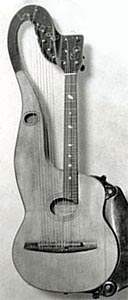 |
 full photograph |
|
This image of Pietro's surviving instrument has been cropped for publication and is missing a portion of the arm that contains several tuning posts (also cropped are the scroll feet for the stand). It is also possible that this area has broken off or been repaired. It looks like the entire headstock area has been repainted gold (similar to Pasquale's surviving instrument). It is hard to tell by the many historical photos of the same instrument whether it was originally wood, or had a shiny black or painted surface. Fortunately, we are able to clearly the see the surviving label in this image, which is dated 1911. |
Here is another vintage photo
that best shows the entire instrument.
This image shows the instrument on stage with Pietro. This close-up comparison of the historical photo and recent color photo shows the tuners in the exact same location and the location of the missing posts at the edge. |
Pietro also owned and played this chitarra lyra a duo bracci with 3 sub-basses built by the Mozzani atelier. |
| Taraffo's other brother Rinaldo played violin and a
similar Gazzo instrument to Pietro with 6 sub-basses. Note the
different fingerboard inlay, bridge inlays and headstock shape.
This same instrument appears in the photo of Rinaldo with Carrara, seen earlier. |
 |
 |
| Rinaldo's instrument seems to have survived and remained
in the family - but again there is that pesky problem with the different
fingerboard inlays!
Comparing the surviving instrument (two views taken at different sessions at right) to the photo above, everything but the fretboard seems to match exactly - the headstock shape, position of the tuners and posts, soundholes, bridge inlays; it even shows similar wear on the soundboard. The fretboard lines up to the body exactly as in the original photo, the 14th fret marker having been relocated to the (more typical) 15th fret. Either these are two nearly identical instruments, or, again, we are simply seeing a complete new fingerboard. The label is dated 1916. |
 |
 |
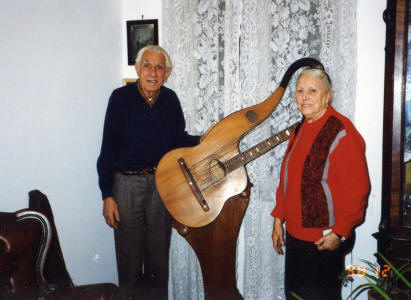 |
This presumed Gazzo harp guitar of Rinaldo Taraffo is in
the possession of Emilio Cagetti
and his wife Ginetta Pastorino (at left). Ginetta is the daughter of
Pasquale's sister Maria. In 1998, Franco (creator of our Taraffo feature) and luthier Antonello Saccu (right) went and measured and photographed the pedestal so that Antonello could build a replica for Beppe Gambetta (see below). |
 |
| Other Players' Instruments |
|
Carrara owned or played at least two or three Gazzo harp guitars over his lifetime, and, having close connections with the extended Taraffo family, had other Gazzo guitars in his possession through the years. Already discussed at the beginning of this article is the 1911 instrument Carrara recently sold to Gazzo's grand-niece Mrs Capurro. Carrara's first instrument, seen in these first photographs is certainly unique, with that distinctive bass headstock silhouette. While I have labeled it the "Carrara style" for discussion purposes, it was played and built by others as well. |
 |
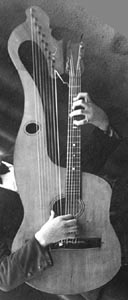 (att. Gazzo) |
 |
 |
In the picture to our immediate left, Carrara poses with the same instrument - or does he? Here is that pesky problem with the fretboard inlays again - except this time the instrument is seen in the exact same time period. Note the last inlay (at or beyond the body joint) in each photo. Same guitar? The headstocks and tuners certainly seem to match. |
 (att. Gazzo) |
 |
Carrara later performed on a different instrument with Taraffo's brother, Rinaldo. |
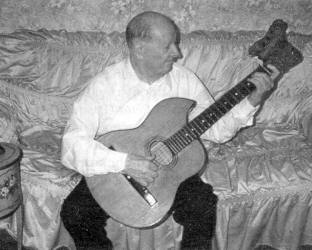 |
Carrara later in life (at left and below) with yet another Gazzo guitar. This 1909 specimen was opened up for restoration by Gianni Accornero only to discover a personal inscription from Gazzo to Taraffo, stating, "Per l'amico carissimo Pasquale Taraffo Genova 1909" ("To my very dear friend Pasquale Taraffo, Genova, 1909"). |
|
Taraffo in turn gave Carrara more than one Gazzo harp guitar over the course of their friendship. The date on this last instrument shows that Gazzo simultaneously created this uniquely flared, theorbo-style instrument at the same early date as the more common Taraffo hollow arm models. |
 |
| Attilio
Albano (1903-1991)
Albano, another friend of Carrara's (and presumably Taraffo) played two Gazzo-style instruments, one with 8 sub-basses, one with 7. The builder of the fancier instrument is unknown, the other may very well be a surviving Gazzo, seen below. Photos circa 1930 (Albano is the darker haired, older gentleman). |
|||
 |
 |
 |
 |
|
Mario Schenone (1904-1976) & Arturo Del Corso (1908-1980) Franco Ghisalberti supplied the following information for these two players of intriguing Gazzo-like instruments. |
|
|
Arturo Del Corso was born in |
|
|
Today, they can be said to be the most representative guitarists in
the field of popular music that followed Taraffo. These additional photographs of Del Corso (left) and Schenone (right) show their harp guitars to best advantage - we can even see the labels through the soundholes! Although, agonizingly, we cannot read them, they definitely do not appear to be any of the known Gazzo labels, nor the Poggi labels. These are very intriguing instruments, as they clearly follow a Gazzo design, but have other unique features. |
| The bass headstock affair is a near duplicate of one of Taraffo's own early instruments (compared at right) - surely made by Gazzo - and the bridge looks just like Gazzo's. However, the "S" holes in the arm - reminiscent of the Albano instrument above - are different and distinctive, as is the "triangle" pattern of both soundhole rosettes - normally simple solid rings in all other Gazzo instruments. These two instruments were obviously made by the same person, at the same time. In fact, when we observe that the distinctive Italian jumbo-body 6-string guitars used by the duo in 1940 share the exact same triangular design soundhole inlay, we can deduce that those were built by the same maker who made these two harp guitars. As the labels appear not to match anything else, and considering the time frame of the duo's career (and later 6-strings), I would guess that these represented another maker of "Taraffo/Gazzo style instruments - at least three makers (but likely several) so far. |
 |
 |
 |
|
Taraffo's early harp guitar (almost unquestionably a Gazzo) |
Del Corso's instrument |
Schenone's instrument |
| Andrea Gaddi
Postcard sent from Gaddi to Carrara on June 26, 1930. His instrument, a 14-string, simple curve style - and likely a Gazzo - is identified uniquely by the lower-protruding extension of the bass attachment. |
 |
 |
|
|
(attributed to Gazzo) |
 |
 |
|
Taraffo (middle row with his Gazzo guitar) with famed luthier (and accordion player) Cesare Candi (sitting second from right) and group. Oreste Candi is believed to be the violinist seated on the left. |
Seven of the same members - with Candi seated second from left, with this brother behind him - pose with the same two harp guitars that may or may not have been made by Gazzo (see below). |
|
From Cesare Candi Litutista - I liutai della famiglia Candi by kind permission of Alberto Giordano |
From Un secolo di Liuteria Italiana 1860 -1960 by E. Blot & A. Giordano, Turris, 1997 |
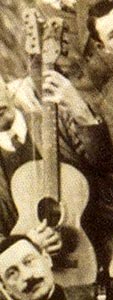 (unknown) |
 (unknown) |
Though resolution is poor, both of these theorboed instruments (at left) appear to have headstocks reminiscent of Gazzo's. The specimen on the right has a distinctive flare as seen on known Gazzo instruments below. However, it's bridge does not match the standard Gazzo bridge, which is present on every single proven specimen (those with labels) - so must be considered suspect. It is interesting that neither guitarist is playing an instrument made by Candi, himself. As mentioned above, Cesare Candi made fine and highly decorated instruments - like these two incredibly ornate harp guitars at right. One can presume that a harp guitar made by Candi would have been in a completely different price range than a similarly flamboyant, but plainly-made Gazzo. Additional Candi harp guitars are shown and discussed above. |
 C. Candi, 1933 |
 C. Candi The second "neck" of this instrument is actually hollow! |
|
From Cesare Candi Litutista - I liutai della famiglia Candi by kind permission of Alberto Giordano |
||||
| Sergio Reguzzoni |
 (unknown) |
 (unknown) |
|
|
|
|
||
|
The photos above come from Luigi Verrini of Genoa, a descendant of Reguzzoni. Luigi's cousin in California - Enrico Reguzzoni, Sergio's nephew - discovered the images on Harpguitars.net and provided the following information on yet another sadly undocumented "hidden harp guitarist." Enrico writes: "My uncle was a contemporary of Taraffo having been born in 1885 and died in 1974. He was also a teacher and taught at least two others that I know of to play the guitar. "Zio Sergio" learned to play the guitar in Genova in the "scuola chitarristica Genoese." My uncle also had a 15 minute radio program in New York City in the 1930's on WOR - unfortunately, this didn't last long due to a disagreement with the station manager (according to my uncle). He also gave private recitals and concerts in studios and private homes." A guitar in the possession of the family proved to be a very poor American reproduction of his instruments shown. |
Reguzzoni's two instruments are similar to each other, though the bass extension shape is different from any of the Taraffo brother's instruments. Again, the fancier bridges also likely imply another builder, as all positively identified Gazzo guitars feature the same simple bridge design, recognizably different from these. Unfortunately, neither instrument survives. |
||
|
7 sub-basses It almost looks like the last (seventh) bass was added as an afterthought. |
6 sub-basses. A second specimen with a slightly different headstock, a different bridge, and a subtle extra curve in the hollow arm. | ||
|
Luigi Andrini |
 |
 |
|
 |
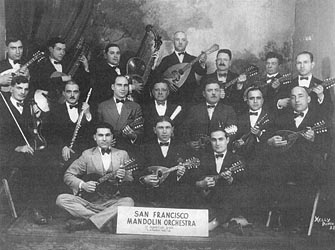 |
||
| The Andrini Troubadours in San Francisco in 1926. Clockwise from left: Fernando, Luigi, Frank and Lorenzino (on mandolira). | Luigi is seen with the same instrument in the back row of the San Francisco Mandolin Orchestra of Exposition Grove, c.1920. |
I was convinced that his instrument was an original Gazzo, and confirmed it when I Bob invited me to photograph it. Other than a couple of repairs and the added pickguard, it was in remarkable condition, complete with label dated 1917. The back and sides are believed to be cypress. Color photographs by Gregg Miner, copyright Bob Andrini |
|
|
The full story on the Andrini (originally Andreini) brothers can be found in the 2005 book Mandolins, Like Salami by Sheri Mignano Crawford. The book contains personal stories about Italian mandolin orchestras in San Francisco, providing rare glimpses into the groups and their members. If not for Sheri, these stories, images and information might never have seen the light of day. Sheri subsequently helped me in contacting the son of Luigi, Bob Andrini, who inherited the very guitar. She states that "the U.S. consulate in Genoa had given the Andreini family permission to immigrate after WW1. My guess is that the father bought the guitar for his son before Luigi took the traversata (as a stowaway!) in 1917. I don't think he would have bought it in N.Y. or S.F. He had it with him, no doubt."
Images from "Mandolins, Like Salami" by Sheri Mignano
Crawford, courtesy of the author. |
|||
| P. Macciò The famous
mandolinist (and Taraffo collaborator) NinoCatania poses with
guitarist P. Macciò in this 1935 photograph. Macciò plays a
flared-body (the bass-side upper bout) theorbo-style
instrument with 4 sub-basses - a model identified so far only with
Gazzo. |
 |
|
(att. Gazzo) Courtesy and © Beppe Gambetta |
| Gaspare Eugenio Cammarata
According to the Dizionario dei Chitarristi e Liutai Italiani, Cammarata also owned and played a Gazzo harp guitar. |
|
Unknown Player / Mario Vecco? The strange instrument seen here may or may not be another Gazzo, and appears in a photograph of Taraffo with an unknown colleague. The extant specimen at right may be this very same instrument. I downloaded it from the Internet many years ago - with only the note "Mario Vecco" - never getting a response from the source. At the time, I didn't know if the name represented the builder or the owner. A third choice: I now wonder if it may have been the original owner in the historical photograph. |
 |
 |
 |
|
Giorgio Bianchi (1913-1979) The first thing I asked when my partner Franco sent me this photo of an "unknown player" (from the collection of Beppe Gambetta) was "What in the world is going on with the headstock decoration ?!" Little did I expect Franco would somehow find out! Franco met one of Bianchi's sisters, who provided information and referred him to nephew Mauro Pittaluga, who kindly provided the following information on the photo at right and also provided additional photos below. |
 |
||
|
"The gentleman in the picture was Mr. Giorgio
Bianchi of Genoa, 1913-1979, a self-taught player who played the
guitar as his passion. He occasionally played with Pasquale
Taraffo when the latter was in Genoa.
The harp guitar in his hands was made by himself and the headstock
decoration came from the top of a piece of furniture in 'baroque
style,' applied in youthful overly-exuberant enthusiasm (he was at
that time 19 years old) - in an attempt to increase the 'appeal' of
his guitar. During his lifetime, Giorgio
Bianchi produced three guitars, two of which he sold to some Spanish
guitar players around 1932, of which we lost any trace.
The third one, the last one, made in September 1932, is owned by
myself and adheres more closely to Gazzo's style, without any
embellishment."
|
|||
 |
Giorgio was one of seven children, all of whom studied music on different instruments. Their father was Benedetto Bianchi (1875-1924) - founder and director general of an important Bank of Genoa. He was thus a very important person and the family was quite wealthy. His wife Andreina had a degree in piano. When the father died young at age 49, the family's financial situation changed and the children could no longer pursue formal music studies. They continued as self-taught musicians, with Giorgio becoming a passionate admirer of Taraffo. Giorgio's sister Margherita recently told us how she helped Giorgio to manufacture his guitars, "bending the wood by submerging it in the water of the bath." She can be seen below left with one of these harp guitars, while Mauro's mother Carmen plays a 6-string guitar. |
||
|
At right is Giorgio's Gazzo-inspired harp guitar showing to spectacular effect the rather original decoration he chose to add... It appears to be the exact same instrument still in the collection of his nephew Mauro - sans adornment. This is a fun puzzle - do these five photos show 1, 2 or 3 different instruments? I am leaning towards a single instrument. Comparison (below) of the five photos in which the same or similar harp guitars appear unfortunately do not resolve (or match) the build sequence Mauro describes above. |
 |
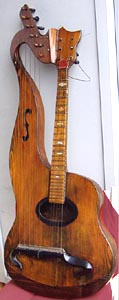 |
|
 |
|||
|
Giorgio's instrument in the first two photos is the same, except for a long single "nut" for the bass strings instead of individual posts in the second, presumably later, image. If this long nut was resting on, rather than inserted into, the headstock, it could have simply been a temporary experiment. The single pearl dot appearing just below the seam of adjoining wood on the narrow part of the arm is present in all photos, except of the latter Giorgio photo - unless it is blurred by movement and lighting (likely). The elaborate furniture piece appears the same in all the photos, though perhaps with more wear over time. Everything else seems to exactly match across the five photos except for the shape of the bridge - on the bass side in the photo of the girls, and on the treble side in the first Giorgio photo. I can only assume that Giorgio made numerous repairs to this instrument, replacing the bridge (once or twice), plus adding a light-colored inlay or overlay at the tail of the guitar, which is missing on the surviving instrument where this entire section of the top has been crudely repaired. |
|||
|
All Bianchi photos courtesy and © Mauro Pittaluga |
|||
| Additional Surviving Specimens Note that in every single case of a proven Gazzo instrument - those with surviving labels, and including Taraffo's personal instruments - the bridge uses the same simple design (sometimes a little more "square" rather than convex on the bottom). This suggests to me that perhaps Gazzo utilized only this bridge shape (with the exception of the simpler rectangular shape of the first, early instrument below). If true, then when we see an unlabeled instrument or vintage photographed instrument with a fancier carved or shaped bridge, we would suspect that it was likely built by someone else. Unfortunately, other builders - like Poggi and the unknown builder of the Schenone and Del Corso instruments also copied Gazzo's bridge design. So we cannot assume the reverse (that the Gazzo bridge shape = Gazzo built). |
||
| A late (Aug, 2008) addition to this study, this first instrument - owned by Paolo Mereu - is a fantastic find as it is the earliest known Gazzo - 1901. Note also the different address. This then would seem to definitively answer the question of whether Gazzo was building harp guitars before he met Taraffo. Now that we know that to be true, it is perhaps not surprising that it would be the simpler theorbo-style (Taraffo's 1909 still the earliest known label on a hollow-arm guitar). The inlaid wood leaf (if original) is a wonderful variation. This and the fancy rosette (round rather than the usual oval) make this instrument appear a bit more sophisticated than usual. |
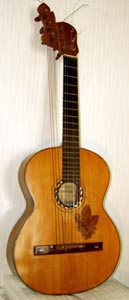 |
 |
 |
The same distinctive bass headstock as seen on Carrara's distinctive instrument above appears on this surviving instrument, which is a different example, as can be seen from several features. Dated 1914, it's provenance is unproven, but is said to be another of Pasquale's instruments, inherited by his son, Prospero, who sold it to well known Genoese lute maker Romeo Bellando. This is where it was purchased by the current owner, Giorgio Ferraris (professional lutenist and historical guitar collector), around 1966. Giorgio adds that "the guitar was restored in Milano by Civica Scuola di Liuteria del Comune di Milano" (Milan Lute Making School). They also "copied a historical pedestal found at a Taraffo’s cousin home (this is the same stand that Antonello Saccu copied, as mentioned earlier - GM). We took pictures and drawings. The stand was built by one of the school teachers. I personally put some old original decoration on the front side. It seems to be in quite good playable condition." I would speculate that somewhere along the way it may have been played by Attilio Albano as well, as an intriguing photo above hints at. |
 |
| Label Back Reproduction Stand | This instrument has seven sub-basses - seen at right, the lowest tuner is missing (the rope holder using the hole). Yet another frustrating identification problem, the distinctive bass headstock shape and position of the 7 tuners and posts (seven also being an unusual number) seem to precisely match that of the instrument seen in the Albano photo. Yet the main headstock is clearly a different shape (and the fretboard inlays are again different). Two different instruments, or a simple neck/head replacement? Likely the latter - note the seam/patch in the main headstock where it joins the bass extension. |
 |
 |
 |
These two instruments are in the collection of Adriano Chierchini.
The one on the left, dated 1918 has four basses attached theorbo-style to a headstock extension piece. The sharp flare on the bass-side upper bout is very unusual, distinctive and attractive.
Note that neither instrument has feet for attaching to a stand.
|
 |
Adding additional sub-basses to an existing configuration was not uncommon. In the case of the instrument at right (owned by Renato Ceccherelli) an unusual "after-market" bass extensions was clearly added at some point. This added extra length and a seventh string. |
 |
| Nearly identical to the previous specimen, the theorboed Gazzo10-string at left is owned by restaurateur Ugo Moltedo. His father bought it from Gazzo himself upon his return from World War I, and the instrument is dated 1919. | These two additional "simple
curve" models are owned by, respectively, Franco Ghisalberti and
Pio Montanari.
The specimen on the right has an unusual wood nut for the basses along
the rim. This is seen in at least two other instruments (in the row
below). Left: 1917, 8 sub-basses Right: 1915, 6 sub-basses |
 (att. Gazzo) |
 (att. Gazzo) |
 (not Gazzo) |
 (Unknown) |
|||||||||||||||||
| My Gazzo has no label, but
we recognized Gazzo's work immediately. It is extremely similar
to Taraffo's main instrument.
8 sub-basses, spruce top, birch back & sides, walnut headstock and feet.
|
6 sub-basses This instrument has a long slotted "nut" for the basses rather than the normal Gazzo "nut posts." Pickguard not original. Owned by Todaro's Music |
6 sub-basses This instrument has a long slotted "nut" for the basses rather than the normal Gazzo "nut posts." It was on display in an unspecified Italian museum, taken by my correspondent Christian Steinbrecher. |
8 sub-basses This specimen has unusually straight lines within the bass arm curve, plus an interesting flared headstock. These features, along with the more decorative bridge would lead us to suspect it was not built by Gazzo - and such is the case. The neck block contains this maker's stamp, that we so far have been unable to read.Image courtesy of Ian Watchorn |
6 sub-basses Luthier and harp guitar expert Benoit Meulle-Stef of Belgium thinks this instrument is too crude to be a Gazzo; I believe it could still be a Gazzo candidate, but of course, we now know he was widely copied. Collection of Tony Bingham |
||||||||||||||||
| Other Makers |
| Francesco Poggi Poggi was at least one local Genoese builder who copied Gazzo's designs either during the same period, or immediately after. The three harp guitars currently known each duplicate Gazzo's instruments fairly accurately, including body shape and bridge configuration. They seem to be a bit wider than Gazzo's, particularly on the bass side of the instrument. The instrument second from left, owned by Beppe Gambetta, features an original, non-Gazzo design for the bass extension and is dated 1924, interestingly, a year after Gazzo's death. Was he "carrying on the tradition" - or perhaps supplying local players who still wished for this style of instrument? |
|
 Poggi Label |
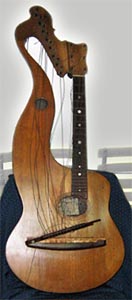 Poggi Label |
|
|
The third instrument from the left is undated and very similar to the "Carrara-style" instrument seen at
right - which I believe to be a Gazzo (the label seen through the
soundhole can be identified in the blown-up image). The Dizionario dei Chitarristi e Liutai Italiani lists guitarist Danilo Favelli (1916-?) of Ferrara as a player of a Poggi with 8 sub-basses. Unfortunately, the discovery of Poggi's harp guitars - unknown until 2008 to all but a handful of Genoese guitar aficionados - forces us to question the true maker of any "Gazzo" harp guitar seen in historical photos or extant specimens with missing labels. |
||||
|
Enrico Ventura This builder from Carate Brianza (Northern Italy) clearly copied the Gazzo "flared model," re-imagining it as a 6-string. It may be that Gazzo (or Poggi, or others) made 6-string versions as well - it is certainly a distinctive and attractive design! |
 |
| Reproductions |
 |
 |
 |
 |
 |
|||
|
When Beppe Gambetta requested a reproduction of Taraffo's harp guitar, luthier Antonello Saccu painstakingly copied Taraffo's personal instrument in the “National Music Liceo Niccolò Paganini" and an original stand in the possession of Emilio Cagetti and his wife Ginetta Pastorino (shown above) to create this beautiful modern copy. |
Antonello Saccu (for Beppe Gambetta) |
||
| Beppe Gambetta No one today is a bigger proponent of the music and legacy of Pasquale Taraffo than Beppe Gambetta. Ironically, though a Genoa native, Beppe's guitar playing style is American Bluegrass. Nevertheless, he passionately promotes and presents the music of his beloved Taraffo on two reproduction Gazzo guitars built by Antonello Saccu. Since the 1990's, he has performed in concerts accompanying singers, dancers and mandolinists like partner Carlo Aonzo. They have recorded two CDs of music by Taraffo and other composers, one of these in conjunction with famed American mandolinist David Grisman. |
|
 |
 |
| Serenata | |
 |
 |
| Traversata | Chitarra Zimarre |
|
Settimio Gazzo - we applaud you! |
|
 |
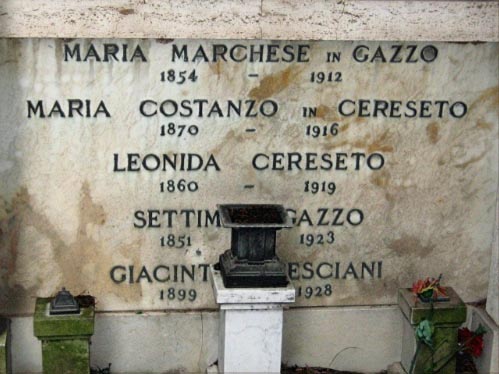 |
| The tomb of Settimio Gazzo today - situated in the Monumental Cemetery of Staglieno in Genoa. Photos by Enrico Defilippi. | |
| To The Gazzo Reference Library |
|
Special thanks to: Antonello Saccu, Beppe Gambetta, Alberto Giordano, Pio Montanari, Simona Ravano, David Hallworth, Enrico Defilippi, Gianni Accornero, Adriano Chierchini, Fabrizio De Ferrari, Giorgo Ferraris, Patrizia Conti, Director of the Conservatory Nicolo Paganini, Ugo Moltedo, Danilo Gosti, Sheri Mignano Crawford, Bob Andrini, Luigi Verrini, Enrico Reguzzoni, Frank Nordberg, Andrea Sibilio, Benoît Meulle-Stef, Gianni Binelli, Mary Kalau, Gino Di Rosa, Renato Ceccherelli, Mauro Pittaluga, and above all, Franco Ghisalberti.
Updates |
| To Taraffo HOME |
| If you enjoyed this page, or
found it useful for research, please consider supporting
Harpguitars.net so that this information will be available for
others like you and to future generations. Thanks!
|
|
|
|
All Site Contents Copyright © Gregg Miner, 2004,2005,2006,2007,2008,2009,2010,2011. All Rights Reserved. Copyright and Fair Use of material and use of images: See Copyright and Fair Use policy. |